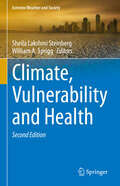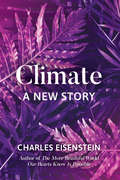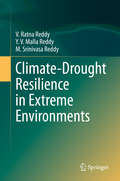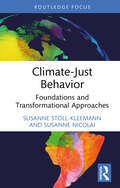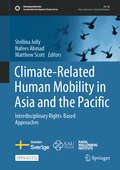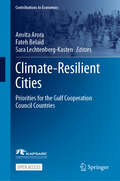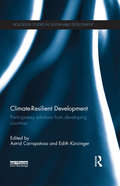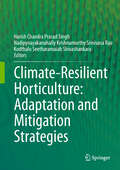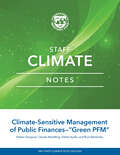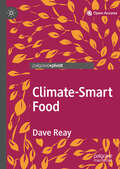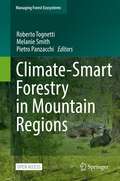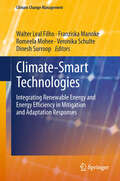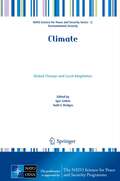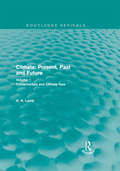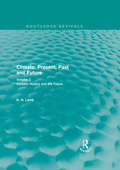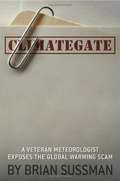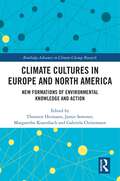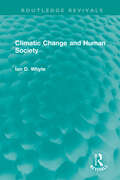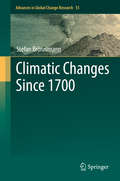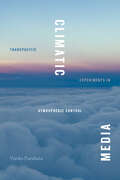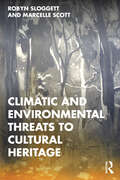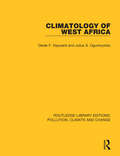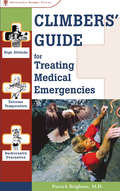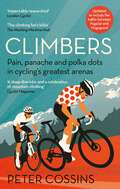- Table View
- List View
Climate, Vulnerability and Health (Extreme Weather and Society)
by Sheila Lakshmi Steinberg William A. SpriggThis contributed volume explores the intersection between climate change, vulnerable communities, and health. It includes a variety of case studies that highlight how changing physical and social environments impact the health of communities across geographies. The COVID-19 Pandemic and climate change together highlighted how social disparities and environmental inequalities in our society affect the health and well-being of people and places impacted by modern crises. This new volume, which appears in the book series Extreme Weather and Society, addresses the plight of socially vulnerable people and communities dealing with extreme weather and other latent and emerging risks. This book is meant for people who have an interest in climate change, extreme weather, and their impact on people and places around the world. Special focus is placed on the knowledge of local populations and the imperative to engage with people within the context their local culture, ethnicity, and geographies. The book is interdisciplinary and crosses the fields of geography, environmental studies, environmental science, climate science, environmental health, emergency management, environmental sociology, social work and public health among others. The book will appeal to anyone who studies, makes, or carries out social and environmental policy—especially to community leaders who must respond to health and environmental challenges within the context of social disparities.
Climate--A New Story
by Charles EisensteinFlipping the script on climate change, Eisenstein makes a case for a wholesale reimagining of the framing, tactics, and goals we employ in our journey to heal from ecological destruction With research and insight, Charles Eisenstein details how the quantification of the natural world leads to a lack of integration and our “fight” mentality. With an entire chapter unpacking the climate change denier’s point of view, he advocates for expanding our exclusive focus on carbon emissions to see the broader picture beyond our short-sighted and incomplete approach. The rivers, forests, and creatures of the natural and material world are sacred and valuable in their own right, not simply for carbon credits or preventing the extinction of one species versus another. After all, when you ask someone why they first became an environmentalist, they’re likely to point to the river they played in, the ocean they visited, the wild animals they observed, or the trees they climbed when they were a kid. This refocusing away from impending catastrophe and our inevitable doom cultivates meaningful emotional and psychological connections and provides real, actionable steps to caring for the earth. Freeing ourselves from a war mentality and seeing the bigger picture of how everything from prison reform to saving the whales can contribute to our planetary ecological health, we resist reflexive postures of solution and blame and reach toward the deep place where commitment lives.
Climate-Drought Resilience in Extreme Environments
by V. Ratna Reddy Y. V. Reddy M. Srinivasa ReddyThis book assesses the effectiveness of changes in watershed interventions in one of the most fragile resource regions of India. Specifically the chapters examine various watershed centred interventions and their implementation process. An evaluation of the livelihood impacts, including crop production on the communities, is discussed and an assessment of the drought and climate resilience of households in the context of watershed and related interventions, including institutions and capacity of the communities, is investigated. Lessons are drawn to further identify measures to strengthen and improvise interventions for enhanced climate-drought resilience in harsh environments.
Climate-Just Behavior: Foundations and Transformational Approaches (Routledge Focus on Environment and Sustainability)
by Susanne Stoll-Kleemann Susanne NicolaiThis book highlights the obstacles to and potential for a just transformation as a way out of the current climate crisis.This volume examines the barriers, opportunities and incentives around the pursuit of climate-just behavior, based on a comprehensive interdisciplinary and integrative analysis. It investigates how the gap between expressing concern about the climate crisis and giving it a high priority within the context of everyday behavior can be overcome. At the same time, it looks at the challenging politico-economic framework conditions such as the strong economic growth and profit orientation of capitalism. Although justice is a fundamental human motive, which should induce climate-just behavior, system justification is common and makes people rather justify their unjust behavior. In this book, a general and systemic framework on human behavior is provided, including internal factors, such as knowledge and psychological needs, external factors, such as socio-cultural and politico-economic factors, feedback loops and interactions. The authors draw on multiple theories to examine how denial and moral disengagement affect individual responsibility, despite real-world evidence of the climate crisis. The book highlights the role of emotions in encouraging a pro-environmental response and discusses solutions on both the individual and the collective level, such as transparency laws. Moreover, making climate-friendly options more accessible, affordable and convenient facilitates behavior change more effectively. Overall, this book presents knowledge-based, realistic approaches to surmounting these obstacles in order to achieve a more climate-just world.Climate-Just Behavior will be of great interest to students and scholars of climate change, climate justice, environmental geography and environmental psychology.
Climate-Related Human Mobility in Asia and the Pacific: Interdisciplinary Rights-Based Approaches (Sustainable Development Goals Series)
by Matthew Scott Stellina Jolly Nafees AhmadThis open access book critically examines the policies and practices related to climate-related human mobility in Asia-Pacific and the legal and policy protection framework for climatically displaced migrants (CDMs) through an interdisciplinary human rights-based approach. While covering the policy and theoretical dimensions of mobility, it also evaluates the issue through empirical studies. The book illustrates how interdisciplinary rights-based approaches address and identify gaps in the protection framework for the region regarding dimensions of climate change displacement, migration, forced migration, susceptibility to climate change, and typology of climate change-induced displacement. Presenting multiple case scenarios, it recommends a legal mechanism based on human rights in a region brimming with variety and multiculturalism. Bringing together voices from the Asia-Pacific Academic Network on Disaster Displacement, the book examines issues that are immediately relevant in countries where they are living and working. In addition to academic perspective, the chapters also bring perspectives from positions held in national human rights institutions and government. They bring insight into lived experience and policy processes, seeking to avert, minimize, and address displacement, including through general disaster risk reduction and climate change adaptation initiatives, as well as specific initiatives around emergency preparedness for response and planned relocation and resettlement. The chapters examine diverse forms of human mobility, including displacement, planned relocation, and forced immobility. The combination of studies focusing on both sudden onset and slower onset movement is also distinctive. With a thorough understanding of the interdisciplinary rights-based approaches to the issue, students, researchers, policymakers, administrators, and all those engaged in studying these topics can quickly evaluate and appreciate how the rights of CDMs are protected on a national, regional, and international level in Asia-Pacific.
Climate-Resilient Cities: Priorities for the Gulf Cooperation Council Countries (Contributions to Economics)
by Fateh Belaïd Anvita Arora Sara Lechtenberg-KastenThis edited volume discusses the concept of resilient cities within the Gulf Cooperation Council (GCC) region. Written by an international panel of scholars and experts, the book presents theoretical approaches, identifies risk factors, and suggests policies for building resiliency in a region of the world undergoing rapid urbanization. Chapters cover a diverse range of topics, including innovative concepts and studies in resilient city design, the interaction of social, entrepreneurial, governmental, and ecological transformations in the GCC region, and international best practices for risk reduction. Coupling rigorous economic analysis and practical policy implications, this book will be useful for students and academics of finance, governance, energy and resource economics, and climate change, as well as policymakers, community leaders, and risk reduction professionals.This is an open access book.
Climate-Resilient Development: Participatory solutions from developing countries (Routledge Studies in Sustainable Development)
by Astrid Carrapatoso Edith KürzingerThe concept of resilience currently infuses policy debates and public discourse, and is promoted as a normative concept in climate policy making by governments, non-governmental organizations, and think-tanks. This book critically discusses climate-resilient development in the context of current deficiencies of multilateral climate management strategies and processes. It analyses innovative climate policy options at national, (inter-)regional, and local levels from a mainly Southern perspective, thus contributing to the topical debate on alternative climate governance and resilient development models. Case studies from Africa, Asia, and Latin America give a ground-level view of how ideas from resilience could be used to inform and guide more radical development and particularly how these ideas might help to rethink the notion of 'progress' in the light of environmental, social, economic, and cultural changes at multiple scales, from local to global. It integrates theory and practice with the aim of providing practical solutions to improve, complement, or, where necessary, reasonably bypass the UNFCCC process through a bottom-up approach which can effectively tap unused climate-resilient development potentials at the local, national, and regional levels. This innovative book gives students and researchers in environmental and development studies as well as policy makers and practitioners a valuable analysis of climate change mitigation and adaptation options in the absence of effective multilateral provisions.
Climate-Resilient Horticulture: Adaptation And Mitigation Strategies
by Nadipynayakanahally Krishnamurthy Rao Kodthalu Seetharamaiah Shivashankar Harish Chandra SinghClimate change, a global phenomenon, has attracted scientists to contribute in anticipatory research to mitigate adverse impacts, which are more important for horticulture, considering that the scenario is in the midst of revolution, reaching the production level of 250 million tonnes in India. Impacts of climate variability have, invariably, profound influence on production and quality. An understanding of the impacts and relevant adaptation strategies are of foremost importance to sustain the productivity and profitability of horticulture crops in the climate change scenario, which necessitates synthesis of current knowledge to develop strategies for adaptation and mitigation to achieve climate-resilient horticulture. The book Climate-resilient horticulture: adaptation and mitigation strategies addresses the effects of climate change on different horticultural crops and focuses on the adaptation strategies based on the scientific knowledge generated by the experts in different agro-climatic regions in India. Issues have been covered in various chapters to make this book a treasure of knowledge in horticulture vis-a-vis climate change. Some of the crops included in the book are apple, grapes, cashew, banana, litchi, mango, coconut, oil palm, potato, tomato, cucurbits and flowers. In addition to strategies to be adapted in these crops, various other important aspects like carbon sequestration, pests and diseases, and urban landscaping are also covered in the book. Information on climatic risks and adaptation options for resilience in horticultural crops and future strategies and information on pest and disease dynamics on horticultural crops in relation to climate change and available mitigation strategies have also been documented. The book is edited by Dr H P Singh, a visionary leader, and his colleagues, which will be highly valuable to research workers, students, policy planners and farmers to understand and checkmate the adverse effect of climate change, so as to convert weakness into opportunity.
Climate-Sensitive Management of Public Finances—"Green PFM"
by International Monetary FundA report from the International Monetary Fund.
Climate-Smart Food
by Dave ReayThis open access book asks just how climate-smart our food really is. It follows an average day's worth of food and drink to see where it comes from, how far it travels, and the carbon price we all pay for it. From our breakfast tea and toast, through breaktime chocolate bar, to take-away supper, Dave Reay explores the weather extremes the world’s farmers are already dealing with, and what new threats climate change will bring. Readers will encounter heat waves and hurricanes, wildfires and deadly toxins, as well as some truly climate-smart solutions. In every case there are responses that could cut emissions while boosting resilience and livelihoods. Ultimately we are all in this together, our decisions on what food we buy and how we consume it send life-changing ripples right through the global web that is our food supply. As we face a future of 10 billion mouths to feed in a rapidly changing climate, it’s time to get to know our farmers and herders, our vintners and fisherfolk, a whole lot better.
Climate-Smart Forestry in Mountain Regions (Managing Forest Ecosystems #40)
by Melanie Smith Roberto Tognetti Pietro PanzacchiThis open access book offers a cross-sectoral reference for both managers and scientists interested in climate-smart forestry, focusing on mountain regions. It provides a comprehensive analysis on forest issues, facilitating the implementation of climate objectives. This book includes structured summaries of each chapter.Funded by the EU’s Horizon 2020 programme, CLIMO has brought together scientists and experts in continental and regional focus assessments through a cross-sectoral approach, facilitating the implementation of climate objectives. CLIMO has provided scientific analysis on issues including criteria and indicators, growth dynamics, management prescriptions, long-term perspectives, monitoring technologies, economic impacts, and governance tools.
Climate-Smart Technologies: Integrating Renewable Energy and Energy Efficiency in Mitigation and Adaptation Responses (Climate Change Management)
by Walter Leal Filho Romeela Mohee Dinesh Surroop Franziska Mannke Veronika SchulteThe book addresses the perceived need for a publication with looks at both, climate smart technologies and the integration of renewable energy and energy efficiency in mitigation and adaptation responses. Based on a set of papers submitted as part of the fifth on-line climate conference (CLIMATE 2012) and a major conference on renewable energy on island States held in Mauritius in 2012, the book provides a wealth of information on climate change strategies and the role of smart technologies. The book has been produced in the context of the project "Small Developing Island Renewable Energy Knowledge and Technology Transfer Network" (DIREKT), funded by the ACP Science and Technology Programme, an EU programme for cooperation between the European Union and the ACP region.
Climate: Global Change and Local Adaptation (NATO Science for Peace and Security Series C: Environmental Security)
by Igor Linkov Todd S. BridgesRising sea levels and altered weather patterns are expected to significantly alter coastal and inland environments for humans, infrastructure and ecosystems. Potential land-use changes and population increases, coupled with uncertain predictions for sea level rise and storm frequency/intensity represent a significant planning challenge. While efforts to mitigate climate change continue, plans must be made to adapt to the risks that climate change poses to humans, infrastructure, and ecosystems alike. This book addresses integrated environmental assessment and management as part of the nexus of climate change adaptation. Risk analysis has emerged as a useful approach to guide assessment, communication and management of security risks. However, with respect to climate change, an integrated, multi-criteria, multi-hazard, risk-informed decision framework is desirable for evaluating adaptation strategies. The papers in Part 1 summarize societal and political needs for climate change adaptation. Part 2 includes papers summarizing the state of the art in climate change adaptation. Three further parts cover: the process of change in coastal regions, in inland regions, and, finally, the potential challenges to homeland security for national governments. Each of these parts reviews achievements, identifies gaps in current knowledge, and suggests research priorities.
Climate: Volume 1: Fundamentals and Climate Now (Routledge Revivals: A History of Climate Changes)
by H. H. LambFirst published in 1972, this first volume of Professor Lamb’s study of our changing climate deals with the fundamentals of climate and climatology, as well as providing global data on the contemporary climates of the twentieth century.
Climate: Volume 2: Climatic History and the Future (Routledge Revivals: A History of Climate Changes)
by H. H. LambFirst published in 1977, the second volume of Climate: Present, Past and Future covers parts 3 and 4 of Professor Hubert Lamb’s seminal and pioneering study of climatology. Part 3 provides a survey of evidence of types of climates over the last million years, and of methods of dating that evidence. Through the earlier stages of the Earth’s development the book traces what is known of the various geographies presented by the drifting continents and indicates what can be learnt about climatic regimes and the causes of climatic change. From the last ice age to the present our knowledge of the succession of climates is summarized, indicating prevailing temperatures, rainfalls, wind and ocean current patterns where possible. Part 4 considers events during the fifteen years prior to the book’s initial publication, leading on to the problems of estimating the most probable future course of climatic development, and the influence of Man’s activities on climate. Alongside the reissue of volume 1, this Routledge Revival will be essential reading for anyone interested in both the causes and workings of climate and in the history of climatology itself.
Climategate: A Veteran Meteorologist Exposes the Global Warming Scam
by Brian SussmanDangerous winds are blowing across America's culture today, creating an atmosphere of extreme anxiety. So why is the government making things worse? Former TV meteorologist turned talk show host Brian Sussman wondered that for years, and a decade's worth of investigation has yielded one of the most shocking stories of our time. In CLIMATEGATE, Sussman uncovers the following: * Communist founders Marx and Engels drafted the inspiration that drives today's environmentalist leaders. * Despite rigorous government-sponsored efforts to alter the record, past climate was significantly warmer than today. * Though only a minuscule sliver of earth's atmosphere, carbon dioxide is an essential nutrient for life and, when increased, can prove quite beneficial. * Barack Obama's presidency is a dream come true for those seeking to use the environment to destroy the United States. * Global warming is a convenient theory that is allowing venture capitalists, international bankers and multinational corporations to reap billions--and fellow travelers to imagine a one-world government. * Al Gore's Oscar-winning film should be considered a work of fiction. * Government agencies, elitist politicians and environmentalists are working together to block the expansion of both alternative and traditional energy resources. * The United Nation's policies have worked their way directly into U.S. environmental laws. * The recently leaked e-mails from Great Britain's climate center are further confirmation of a years-long, complex cover-up. * Updating the nation's energy grid is designed to bring Big Brother inside our home. In his book, CLIMATEGATE, Sussman combines his keen ability to readily explain complex scientific subjects with his astute political observations, driving home his conviction: the theory of man-made global warming is a fraud and many of the high-profile personalities fronting such claims are charlatans purposed to change society and make loads of cash.
Climate Cultures in Europe and North America: New Formations of Environmental Knowledge and Action (Routledge Advances in Climate Change Research)
by Thorsten HeimannBringing together scholarly research by climate experts working in different locations and social science disciplines, this book offers insights into how climate change is socially and culturally constructed. Whereas existing studies of climate cultural differences are predominantly rooted in a static understanding of culture, cultural globalization theory suggests that new formations emerge dynamically at different social and spatial scales. This volume gathers analyses of climate cultural formations within various spaces and regions in the United States and the European Union. It focuses particularly on the emergence of new social movements and coalitions devoted to fighting climate change on both sides of the Atlantic. Overall, Climate Cultures in Europe and North America provides empirical and theoretical findings that contribute to current debates on globalization, conflict and governance, as well as cultural and social change. This book will be of great interest to students and scholars of climate change, environmental policy and politics, environmental sociology, and cultural studies.
Climatic Change and Human Society (Routledge Revivals)
by Ian D. WhyteOriginally published in 1995, this book brings together material from many sources and offers a balanced appreciation of the ways in which climatic changes can interact with society. The questions it discusses are as relevant now as when the book was published: how far should governments go in taking expensive and unpopular measures to reduce greenhouse gas emissions? Will the warming trend produce results as dire as have been predicted? It does not presuppose a background in science and extensive use is made of case studies drawn from around the world to put scientific principles into context. An invaluable book for those approaching the subject for the first time.
Climatic Changes Since 1700 (Advances in Global Change Research #55)
by Stefan BrönnimannThe proposed book is not only a tribute to the work of Brückner (and indeed also a personal tribute, since Brückner wrote his book at the Institute of Geography of the University of Bern), but references to Brückner's book are also a conceptual tool in the proposed book, though used sparingly and thoughtfully. Apart from providing historical context, references may facilitate introducing some complex topics, for instance by first presenting Brückner's view and then complementing the picture with today's understanding. References can be used for contrast: Comparing Brückner's methods and data with today's research concepts makes the progress in the field easily understandable. The enormous growth of information since Brükner's time allows a much more detailed perspective on some scientific problems. Or references can be used to highlight similarity. Some aspects have not changed over time. Finally, the book complements Brückner's studies by adding the arguably most interesting and certainly most relevant period, the past 120 years.
Climatic Media: Transpacific Experiments in Atmospheric Control (Elements)
by Yuriko FuruhataIn Climatic Media, Yuriko Furuhata traces climate engineering from the early twentieth century to the present, emphasizing the legacies of Japan’s empire building and its Cold War alliance with the United States. Furuhata boldly expands the scope of media studies to consider technologies that chemically “condition” Earth’s atmosphere and socially “condition” the conduct of people, focusing on the attempts to monitor and modify indoor and outdoor atmospheres by Japanese scientists, technicians, architects, and artists in conjunction with their American counterparts. She charts the geopolitical contexts of what she calls climatic media by examining a range of technologies such as cloud seeding and artificial snowflakes, digital computing used for weather forecasting and weather control, cybernetics for urban planning and policing, Nakaya Fujiko’s fog sculpture, and the architectural experiments of Tange Lab and the Metabolists, who sought to design climate-controlled capsule housing and domed cities. Furuhata’s transpacific analysis offers a novel take on the elemental conditions of media and climate change.
Climatic and Environmental Threats to Cultural Heritage
by Robyn Sloggett Marcelle ScottClimatic and Environmental Threats to Cultural Heritage examines the challenges that environmental change, both sudden and long-term, poses to the preservation of cultural material. Acknowledging the diversity of human cultural heritage across collecting institutions, heritage sites and communities, the book highlights how, in Australia, Southeast Asia and the Pacific, the quest to preserve such precious knowledge relies on records and narratives being available to inform decisions now and into the future. Bringing together a diverse range of stakeholders who have an interest in – and responsibility for – the care of cultural heritage material and places of cultural heritage value, the book explores their thinking on and actions in relation to issues of climate change and environmental risk. Sloggett and Scott highlight the stakeholders’ shared interest in drawing on their expertise to meet the challenges that environmental change brings to the future of our cultural heritage and our cultural identity. Based on the understanding that this global challenge requires local, national and international co‐operation, the book also considers how local knowledge can have international application. Climatic and Environmental Threats to Cultural Heritage will be of interest to those engaged in the study of heritage, conservation, archaeology, archives, anthropology, climate change and the environment. It will also be useful to practitioners and others attempting to understand the effect of environmental change on cultural heritage around the globe.
Climatology of West Africa
by Derek F. Hayward Julius S. OguntoyinboOriginally published in 1987, this book brings together information previously buried in specialist sources and makes it available to the student in a non-technical and well-illustrated synthesis. It builds a clear and detailed picture of the climates of West Africa, describing and explaining them and showing how crucial this understanding is to everyday life. The climate’s relevance to water resources, agriculture, health and industry is systematically considered.
Climb or Die
by Edward MyersAfter a car accident in a snowy Colorado pass seriously injures their parents, athletic fourteen-year-old Danielle and her brainy younger brother, Jake, must scale a mountain to find help.
Climbers' Guide to Treating Medical Emergencies
by Patrick BrightonFrom pulmonary edema to bashed knuckles, physician and outdoor athlete Dr. Patrick Brighton covers everything a climber needs to know to stay well along the way. Whether bouldering the backyard or seeking shelter high atop Aconcagua, this guide gives readers simple, straight-forward advice to help handle an emergency situation.
Climbers: How the Kings of the Mountains conquered cycling
by Peter CossinsWhen, during the Pyrenean stages of the 1998 Tour de France, a journalist asked Marco Pantani why he rode so fast in the mountains, the elfin Italian, unmistakeable in the bandanna and hooped ear-rings that played up to his "Pirate" nickname, replied: "To shorten my agony."Drawing on the fervour for these men of the mountains, Climbers looks at what sets these athletes apart within the world of bike racing, about why we love and cherish them, how they make cycling beautiful, and how they see themselves and the feats they achieve.Working chronologically, Peter Cossins explores the evolution of mountain-climbing. He offers a comprehensive view of the sport, combining contemporary reports with fresh one-to-one interviews with high-profile riders from the last 50 years, such as Cyrille Guimard, Hennie Kuiper and Andy Schleck. And, unlike many other cycling books, Climbers also includes the stories of female racers across the world, from Ashleigh Moolman-Pasio and Annemiek van Vleuten to Fabiana Luperini and Amanda Spratt.Climbers analyses the personalities of these racers, highlighting the individuality of climbing as an exercise and the fundamental fact that it's a solitary challenge undertaken in relentlessly unforgiving terrain that requires unremitting effort.Captivating and iconic, Climbers is the ultimate cycling book to understand what it takes both physically and mentally to take on the sport's hardest stages.
